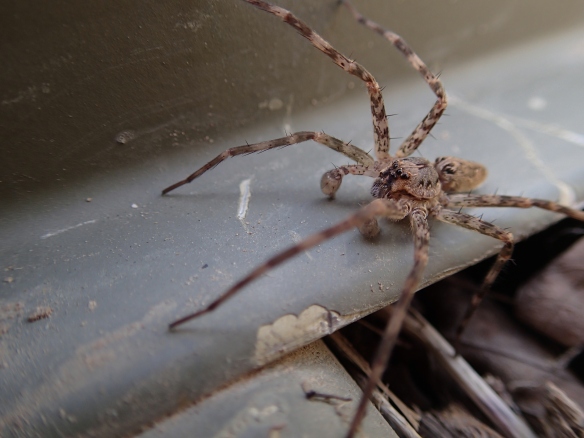I believe in science. I trust it’s facts, it’s ability to be replicated; it’s ability to be put to the test.
I also believe in art. I trust that it is sometimes unmistakably unknowable. I know it makes me feel.
If we have learned something from recent world events, it is that the way we feel about a thing sometimes is more important than what we can observe as truth.
My point is science and conservation in this day and age needs to make people feel something. They have to believe in it.
For example, what do you remember from remember BBC’s Planet Earth or Life documentaries? Do you remember many of the facts from them? ANY of the facts in them? I have watched them a couple times, and what I remember is the feeling the images evoked. The awe, the wonder, the excitement, and yes, even sadness. Those documentaries were art; they made me feel – and that’s what I remember.
Photos, videos, presentations, popular books, other media, and getting people involved are useful tools that can help spur people to feel about science. I know I am not writing anything new here. However, sometimes we forget that our words (as they are interpreted via media outlets) make people feel things.
Much of climate change science suggests scary things: species extinction, economic collapse, disease spread, sea level rise, etc… From different fields associated with biological conservation, we hear news reports of emerging diseases, biodiversity collapse, and disappearing species we love. And don’t get me wrong, much of this is scary, with dire implications. But that can’t be the only conversation we have (with the public), because if it is, no one will want to talk to us.
I understand the scary things make good headlines. But I think that there is good work being done that shows scientific results that make people feel wonder and happiness too. I don’t expect every scientist to be able to do outreach let alone a BBC documentary, but I feel like there are things we could do that would help on a local scale. Instead of aspiring to be a Neil deGrasse Tyson of your field and floundering with expectations, actually become the Neil deGrasse Tyson of your lab, department, or community.
Most scientists I have encountered are creative, curious people. Otherwise they probably wouldn’t have become scientists, those are kinda prerequisites for the job. I know that in my immediate lab, it contains a woodworker, silversmith, 3 different musicians, a graphic designer, and brewers (don’t judge me for thinking a good beer is art, because it is).
Having been steeped and surrounded in my field for so long, I can no longer remember what it is like to encounter my type of work for the first time. I don’t know if someone would be engaged, encouraged, discouraged, scared, or what there impression would be. I do know that I have participated in interdisciplinary art shows that engage audiences to think about the world around in a distinctly scientific mindset. And this was in Lubbock, Texas, so I may state it could be possible anywhere. After listening to people in the exhibit hall, I heard things like, “I never really thought about that.”, “Oh, that’s pretty.”, “I like that.” It wasn’t anything fancy, but it did demand that people interpret a rarely acknowledged resource in a new light. It was instructional to hear people’s feelings about the science-come-art abstractions. It was insight into how they perceived the world around them, specifically the parts of the world I cared about too.
I guess what I want from people is to cross some boundaries (again, nothing new, but come on, when was the last time you did?). Not just across the university or with another state agency or what not, get into some seriously new territory. Work with the theatre department to have them teach communication and presentation skills to young scientists. Reach out to your local art gallery and see if they would host an installation by scientist/artists in your university. Use your photography skills to make nature more accessible so that people care more about a local piece of land that protects species and ecological services that they never new existed. Publish a zine about fieldwork or local natural resources conservation issues in conjunction with an undergrad or high school English class and a local bookstore. Have a second grade class help create a sculpture that can be put in said parcel of land, that also doubles as wildlife habitat (think funky birdhouse installation or whatever you can come up with), or artificial coral reef that they could go and snorkel to and count coral recruitment. Meet with the local rotary, give a presentation, ask for venues to display work. Contact local sportmans’ clubs and see if they have any projects that could benefit both parties (river clean up? Use the trash to create that art installation or figure out if they have land you can use for a research project in return).
If we have enough people start reaching out and engaging locally, whether it is as simple as a social media post of cute wildlife or as complex as involving local NGOs and elementary schools in citizen science and restoration, we can start getting people to feel good about science. When people start feeling good about science, when what they think about conservation isn’t scary world-ending, species-disappearing headlines, we can get them to care. Otherwise a lot of people will just though up their hands and walk away. Even if someone don’t understand a particular topic, we need them to linger, to believe, and to ultimately have trust, like we have, in this adorable monster we call science.

Another adorable monster, look at it!!!!!
P.s. I may be completely wrong. I often am. But at least, I think we should try. I think it may just be worthwhile.
